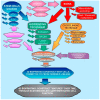Bioprinting and Differentiation of Stem Cells
- PMID: 27617991
- PMCID: PMC6273261
- DOI: 10.3390/molecules21091188
Bioprinting and Differentiation of Stem Cells
Abstract
The 3D bioprinting of stem cells directly into scaffolds offers great potential for the development of regenerative therapies; in particular for the fabrication of organ and tissue substitutes. For this to be achieved; the lineage fate of bioprinted stem cell must be controllable. Bioprinting can be neutral; allowing culture conditions to trigger differentiation or alternatively; the technique can be designed to be stimulatory. Such factors as the particular bioprinting technique; bioink polymers; polymer cross-linking mechanism; bioink additives; and mechanical properties are considered. In addition; it is discussed that the stimulation of stem cell differentiation by bioprinting may lead to the remodeling and modification of the scaffold over time matching the concept of 4D bioprinting. The ability to tune bioprinting properties as an approach to fabricate stem cell bearing scaffolds and to also harness the benefits of the cells multipotency is of considerable relevance to the field of biomaterials and bioengineering.
Keywords: 3D bioprinting; bioinks; differentiation; lineage commitment; stem cells.
Conflict of interest statement
The authors declare no conflict of interest.
Figures




References
-
- Organ Procurement and Transplantation Network. [(accessed on 3 June 2016)]; Available online: https://optn.transplant.hrsa.gov.
-
- Vaezi M., Yang S. Extrusion-based additive manufacturing of peek for biomedical applications. Virtual Phys. Prototyp. 2015;10:123–135. doi: 10.1080/17452759.2015.1097053. - DOI
-
- Dean D., Mott E., Luo X., Busso M., Wang M.O., Vorwald C., Siblani A., Fisher J.P. Multiple initiators and dyes for continuous digital light processing (CDLP) additive manufacture of resorbable bone tissue engineering scaffolds. Virtual Phys. Prototyp. 2014;9:3–9. doi: 10.1080/17452759.2013.873337. - DOI
Publication types
MeSH terms
Substances
LinkOut - more resources
Full Text Sources
Other Literature Sources
Medical

